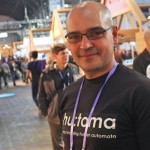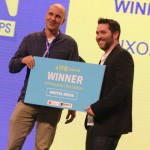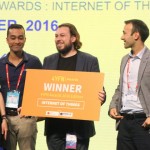The 4 Years From Now (4YFN) event at the Mobile World Congress was all about experiences. Partly due to the popularity surge of the user-experience movement, but it’s also related to the process of creating something from nothing. It was clear that the key to innovation is to build upon past achievements while keeping your eyes on the future. I want to touch upon two highlights from 4YFN: One on knowledge sharing on startups & internationalization and one on trend spotting: All You Can Eat Solutions and Multi-sensory Experiences. To set the mood, I suggest you have the following music playing while reading the rest of this post: Good vibrations or Revolution.
Startups & Internationalization
During the various keynotes, panels and workshops, a lot of attention was paid to scaling up and exponential growth. The dominant credo was that companies should be born globally. The Spain Tech Center proudly presented a bombastic movie to draw international attention to “Something is happening in Spain” and related to “Now is the best moment to invest.”
Hence, a lot of startups and SME’s were searching for information, and more specific, resources to take this step. An example is wikiloc: GPS tracking and outdoor trials for hiking, cycling and other activities. They have > 1,5 million visitors per month, 2 million trails and are already available in 22 languages. This is all being done from their 5-person office in Girona, explains COO Montserrat Jordi. “The time has come to internationalize.”
Different panelists and presentations gave advice and reflections, pointing from one direction to another. While Angels like vision, Venture Capitalists like precision. It became clear that there is no recipe. The level of technical and human assets determines the different paths. Overall, a lot of time is dedicated to understanding the local conditions.
The most important factor, fortunately, is not technology. While the business world is getting obsessed with data, the critical factors for a successful business still fall on the shoulders of people and the importance of finding the right talent. From this perspective, the first step is to internationalize yourself and become a global entrepreneur: travel, learn languages, discover new horizons, be inspired and shake hands, share problems and listen close to get real user insight. And of course the other important factor is customers: “the only way to make a business is to find a customer that buys.” To make the business go viral, it is even better if the customer also becomes an ambassador.
Wearable Experience: smaller, smallest & smartest
We want to be connected. Anytime, anywhere and with (almost) everybody. Connectivity in the broadest sense is driving the ecosystem further. And to achieve connectivity, wearables are taking over; creating new business model opportunities in the wearable world. Wearables are cross-sectorial and can combine ICT with health, fashion, music and so on. The Google Glass (GG) forms a beneficial platform for all kind of new startups, like the on Wednesday launched Eaze: a hands free mobile payment system combining BitCoin and GG. Currently, it still needs a voice command, but with the progress of intuition it is expected that nodding will soon take over.
I was surprised about the amount of people already wearing GG. It looked like all the 2,5% innovators were collected around me. Will you be one of the early adapters? But the GG is not fashionable, a bit uncomfortable to wear and it makes you look like a robot. Referring to the saying ‘closer to the body, closer to the soul’, I would call them digital terminators. But they are real ambassadors for the product, everybody looks at them and is curious about the experience. On the other hand, I wonder whether we would get the sunglasses effect in communication. What effect will it have on human interaction?
Diffusion of Innovation (Roger) credit: suewaters.wikispaces.com
Another interesting line of reasoning was “A better place through smart devices”. Wearables are positioned as a technology that will generate social impact. In this perspective, a lot of products were also aimed at the growing ‘Maker community’.
All that data, all that insight. The data overload is translated to metrics pressure: always in control. The next step is to come up with ‘All you can eat’ solutions for wearable technologies: matching software and hardware. Erasing the necessity to make decision on what device to buy based on features. All features will be included. But will that really make you happier if you know how many steps you made, how high your protein level is, how many…?
And then the obvious question related to privacy. The common view during 4YFN was: ”If you want to make magic happen, you need to share data to have relevant information and customized experience.” Hence, within society two camps will appear, which can be plotted against the line of convenience versus privacy.
The wearables could be divided among three types of use:
1) convenience: the don’t worry app, the aggregate information app, the relax app …
2) life preservation and optimization: the save me app and make me healthier…
3) life augmentation: the see beyond app…
But in general; all want to generate a better experience for the customer. Referring to experience, I want to share my thought with regards to multisensory experience. I think that the real impact will be when multiple senses will be triggered. Therefore, I asked you to play a certain type of music along with the text: combining seeing and hearing. In movies this is already common practice and Oscars can be won for best film music, in fashion and cooking one looks feels texture and sees the design. But there are many more combinations possible. So why experiment with combining multiple senses, that currently aren’t linked? Books with playlists, clothes with nice smells (no deodorant needed),… What would you like to see, feel, smell, touch and hear together?









Leave a Reply